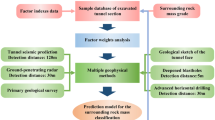Abstract
Independent of the well known classification systems this paper presents an attempt at a subsequent, geological characterisation of the classes of rock mass quality found for three tunnel projects in Austria. Simple statistical treatment of the data shows that joint and bedding-plane spacing, sliding prone fillings and seepage are the most useful geological criteria for characterising the rock mass classes, which themselves had been derived from standard support requirements. Ratio and relative importance of these criteria, however, are quite different for each tunnel project.
Influence of tunnel cross sectional area, depth of cover and orientation of divisional planes could not be proved important on the basis of the data available.
Résumé
L'auteur a essayé de caractériser, indépendamment des systèmes bien connus de classification, la qualité des massifs rocheux à partir de constatations faites dans trois tunnels construits en Autriche. L'étude statistique simple, des données a montré que l'espacement des diaclases et des plans de stratification ainsi que la présence de remplissages prédisposés au glissement et les infiltrations représentent les critères géologiques les plus appropriés pour caractériser les catégories de terrains qui, elles, ont été dérivées de critères tels que quantité d'appui nécessaire etc. Par contre, les rapports entre ces critères géologiques et leur, importance relative sont bien différents pour chaque tunnel.
Les données disponibles n'ont pas permis de constater une influence de la section transversale de la puissance de la couverture et de l'orientation des plans de discontinuité.
Similar content being viewed by others
References
BARTON, N., LIEN, R., LUNDE, J. (1974): Engineering classification of rock masses for the design of tunnel supports.—Rock meth.6, No. 4, 189–236, Wien-New York.
BIENIAWSKI, Z.T. (1973): Engineering classification of jointed rock masses.—The Civ. Eng. S. Africa, Dec. 1973, 335–343.
BIENIAWSKI, Z.T. (1974): Geomechanics classification of rock masses and its application in tunnelling.—3nd Congr. ISRM2; 27–32, Denver.
BIENIAWSKI, Z.T. (1976): Rock mass classification, in rock engineering. —Proc. Symp. Expl. rock engin., Johannesburg.1, 97–106.
BIENIAWSKI, Z.T. (1979): The geomechanics classification in rock engineering applications.—Proc. 4th Cong. ISRM Montreux,2, 41–48.
BROCH, E. (1974): The influence of water on some rock properties. —3rd Congr. ISRM2, 33–38; Denver.
BROSCH F.J. (1982): Zur Baugeologie des Kalcherkogel-tunnels (Pack, Steiermärk/Kärnten).—Mitt. Ges. Geol. Bergbaustud. Österr.28, 177–200; Wien.
BROSCH, F.J., KLIMA, K., PÖLSLER, P. (1984): Baugeologische Erfahrungen beim Ausbruch des Plabutschtunnel-Sondierstollens der A 9 Pyhrnautobahn.—Felsbau, V.2, No. 3; Essen.
CAMRON-CLARKE, I.S., BUDAVARI, S. (1981): Correlation of rock mass classification parameters obtained from borecore and in situ observations.—Engin. Geol.17, 19–53; Amsterdam.
COATES, D.F. (1964): Classification of rocks for rock mechanics.— Int. J. Rock Mech. Mining. Sci.1: 421–429.
DEERE, D.U., PECK, R.B., PARKER, H.W., MONSEES, J.E., SCHMID, P. (1970). Design of tunnel support systems.— Highway research rec.339, 26–33; Washington.
EINSTEIN, H.H., THOMPSON, D.E., AZZOUZ, A.S., O'REILLY, K.P., SCHULTZ, M.S., ORDUN, S. (1983): Comparison of five empirical classification methods—Accuracy, effect of subjectivity and, available informations.—5th Congr. ISRM Melbourne, C 303–C 313.
HELFRICH, K.H. (1975): Gebirgstechnische kennziffern mit petrographisch-struckturellem Begriffsinhalt.—Rock Mech. Suppl.IV, 21–28; Wien-New York.
HEYNE, H.-K. (1982): Gebirgs- und Bauraum-klassifikation für den Tunnelbau.—Z. geol. Wiss10, 8: 1155–1164; Berlin.
IKEDA, K.A. (1970): Classification of rock conditions for tunneling. —1M Congr. IAEG Paris, 1258–1265.
JOHN, K.W. (1977): Geologische und geotechnische Gebirgs-Klassifizierung im Zusammenhang mit dem Entwurf von Felsgründungen.—Ber. 1. Nat. Tagung Ingenieurgeol. 7–22; Paderborn.
LAUFFER, H. (1958): Gebirgsklassifizierung für den Stollenbau.— Geol. u. Bauwesen24, No. 1, 46–51; Wien.
MARSL, D. (1967): Statistische Methoden für Erdwissenschaftler. —152 S. (Schweitzerbart) Stuttgart.
MELLO MENDES, F., AIRES-BARROS, L., PERES RODRIGUES, F. (1966): The use of modal analysis in the mechanical characterisation of rock masses.—Proc. IM Congr. ISRM. V. I., Th. 2, 217–223; Lisboa.
MELLO MENDES, F., OJIMA, L.M. (1982): Geotechnical rock mass classifications applicable to tunnel design and construction.— Proc. IV Congr. IAEG,5 Th. 2, 183–186; Rotterdam.
MONTOTO, M. (1983): Petrophysics: the petrographic interpretation of the physical properties of rocks.—5th Congr. ISRM, B93–B98; Melbourne.
MÜLLER, L. (1963): Der Felsbau, I/1.—624 pp., (Enke) Stuttgart.
NAKAO, K. HHOSHI, S., KOYAMA, S. (1983): Statistical reconsideration on the parameters for geomechanics classification.— 5th Congr. ISRM Melbourne, B. 13–B 16.
ÖNORM B 2203 (1978): Untertagebauarbeiten; Wien.
PACHER, F., RABCEWICZ; L., GOLSER, J. (1954): Zum derzeitigen Stand der Gebirgsklassifizierung im Stollen- und Tunnelbau. —Straßenforsch.18, 51–58; Wien.
ROMANA, M. (1983); Field inventory of tunnels for classification purposes.—5th Congr. ISRM D 207–D210, Melbourne.
SCHIMMER, E.R. (1975): Geotechnische Gebirgssklassifierungen. —Diplom-Arbeit. Ruhr-Univ., Bochum.
SN 56 1198 (Swiss Norm) (1975): Untertagebau.—SIA Zürich.
STAPLEDON, D.H. (1968): Discussion.—Int. J. Rock Mech. Min. Sci.5, 371–373.
TERZAGHI, K. (1946): Introduction to Tunnel Geology.—In: PROCTOR, R.V. & WHITE, Th. (Eds.), Rock Tunneling with Steel Supports.—Commercial Shearing and stamping Co.): Youngstown, Ohio.
WHANG SHI-CHUN, LI SONG-RONG, ZHAN KE-CHENG (1982): A proposal for rock classification in tunnel engineering.— Proc. IV Cong. IAEG, New Delhi5, Th. 2, 229–239; Rotterdam.
WICKHAM, G.E., TIEDEMANN, H.R., SKINNER, E.H. (1972): Support determinations based on geological predictions.— Proc. 1M North Amer. Rapid Excavation and Tunneling Conf. (AIME), 43–64: New York.
Author information
Authors and Affiliations
Rights and permissions
About this article
Cite this article
Brosch, F.J. Geology and the classification of rock masses—Examples from Austrian tunnels. Bulletin of the International Association of Engineering Geology 33, 31–37 (1986). https://doi.org/10.1007/BF02594703
Published:
Issue Date:
DOI: https://doi.org/10.1007/BF02594703




